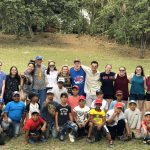
This gallery contains 11 photos.
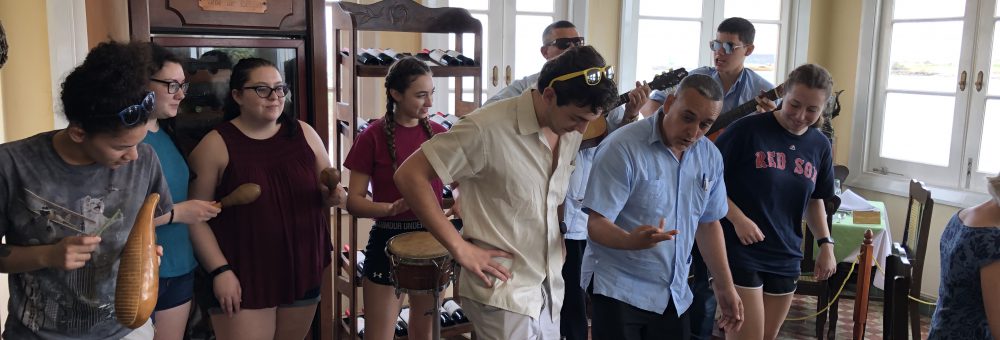

This gallery contains 11 photos.
Our last day in Cuba was meant to be spent exploring Cuba independently; I felt as if I had already experienced everything but wanted to do it all again before we had to leave. We crammed every possible adventure into our last twenty-four hours. Now, thinking about the New England cold as an eight-inch snowfall looms over our return, I want our jam-packed final day to last as long as it possibly can.
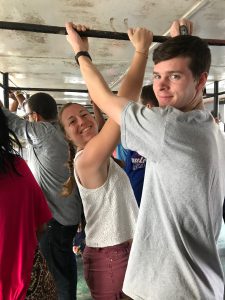
Abby and Liam, thrilled to be riding the ferry.
I started my day on a packed ferry to Regla, visiting the museum of Santeria, a religion developed in Cuba by the Yoruba people as a way to merge their religion with the Catholicism that was forced upon them by the Spaniards colonizing the island. Santeria has adapted Christian symbols, including the use of Lazarus as a god, a virgin mother figure, and crucifix figures scattered throughout the art in the museum. I found the way that Santeria grew as a way to adapt to the rule of Cuba at the time interesting, and an example of a common theme that I found throughout my trip: Cubans have to adapt to whatever power is trying to exert itself upon them.

“The Yoruba people played an important role in the history and culture not only of Nigeria, but of all sub-Saharan Africa.”
Cubans first fought for independence from Spain in the Ten Years War, which Americans know as the Spanish-American War, in our typical fashion of erasing Cuba’s presence. Within the next century, they had to again fight for independence from their own (American-backed) government and have spent the sixty years since surviving under what they call a blockade from the United States. I think that what Santeria and Cuba’s political history show is that Cuba is a nation that will not allow themselves to be stepped on. As our wise guide said during a visit to the Museum of the Revolution: “This is our sh**, let it be our sh**.”
A convertible ride back to our residencia brought me back from my admiration of Cuba’s resilience and to my goal for the day: to experience as much as I could again before our two short weeks in Havana ended. After lunch, a group of us walked to Café O’Reilly, a coffee shop that had become one of my favorite places to relax for an hour. On the way, we met a man that gave us directions to Old Havana and discussed his experience in Cuba. He worked in creating curriculum for public schools and angrily ended our conversation when we mentioned the coffee shop, asking us why Americans chose to frequent government-run shops instead of supporting small private businesses. Even though we had eaten at multiple paladars, privately-owned restaurants, I had almost forgotten that not everyone in Cuba is happy with the socialist government.
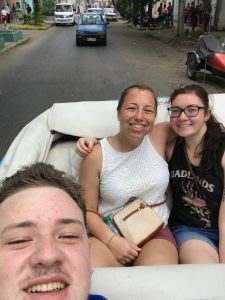
Our last taxi ride.
After our final coffee shop visit, which was a reminder of the scarcity of some resources in Cuba when the shop didn’t have the condensed milk needed for a Café Tres Leches, my favorite drink there, we walked through the packed streets of Old Havana one last time. I found an aviary that I had probably walked by every day but hadn’t noticed. It made me realize how much I had probably missed. (And made me begin to plan a return trip to experience everything that I may have distractedly passed by.) We took a newer cab back to the residencia to meet for our farewell dinner. The ability to ride in an antique car from the 1950’s and a newer Audi in the same day never stopped amazing me; I expected every car in Cuba to be antique, and the newer models proved that Cuba is moving forward much more than I had expected.
Our farewell dinner had me more focused on conversation than on the (insanely delicious) food that we were enjoying. It’s strange to spend two weeks with the same twelve people, and barely any contact with the outside world, and then expect to go back to normal life at home. These past two weeks weren’t just about going to class and exploring Cuban museums, they were about immersing ourselves in an unfamiliar country and culture and trying to absorb as much of it as possible. Part of that immersion was forming the relationships that we did, even if it was a father-son bond with our bus driver, Arturo. Receiving certificates of completion from the CEM, (Centro de Estudios Martianos) where we attended lectures, made the end of this adventure feel real. Cuba will always be a part of all of us, in the memories, souvenirs, and slightly-too-close-up photos of each other, but especially in the friendships that we’ll maintain when we come home.
[“You’ve Got a Friend in Me” from Toy Story plays quietly in the background.]
On this day, we had a lecture on Race in Cuba and visited a farm-to-table restaurant owned and run by an Italian immigrant.
Tomas Fernandez Robaina was the lecturer for the day. Tomas, or Tomasito, as his friends call him for his short stature and affable demeanor, has studied race for decades. According to him, he has taken twenty-five trips to the United States to study with various higher education institutes discussing the complex manifestations of race and race relations in the Republic of Cuba. He has visited such universities as Amherst College and Harvard. When asked about African American writers who were the most influential in his studies abroad, he cited W.E.B Dubois and Booker T. Washington.
The story of race in Cuba is very similar to the one in the United States in that race has been a determinant factor in social status for darker citizens. Slavery was not outlawed in Cuba until nearly two decades after the United States Civil War. Similar to the United States history, the military appears to be the first of the social and governmental institutions to integrate.
The effects of racism were most notably pointed out by the islands most famous political and social thinker: Jose Marti. His essay “Our Race” is thought to capture the true essence of the Cuban disposition toward race. In the essay, Marti calls for unity among the racial factions in order to oppose the threatening forces of the Spanish Colonizers and proposes even broader positive consequences for unification. He denounces divisive attitudes between the races and propositions an ideal of harmony and brotherhood among all Cuban peoples.
There are varying degrees and appearances of racism: structural and implicit, or cultural and blatant. Since the colonization of Latin American countries by Spain, degrees or classes of race have become the norm. Mixed race peoples know greater privilege and priority in the hierarchical social structure. In total, there have been reported more than 40 classes of race in the Spanish colonial caste system. Professor Robaina’s mother was white and his father black, in Cuban society, he is not considered “black” the way he might in America society.
Following the successful attainment of power by Fidel Castro and the communist revolution, Castro declared his intent to end racism. Just two years after his initial claim, Castro announced that racism has been eradicated; a claim which is now contested by many who once accepted his findings. Robaina himself believed the narrative proposed by Castro. In his eyes, there was empirical proof: Blacks were inhabiting political, social, and occupation roles they were formerly barred from. It appeared that structural racism and discrimination had been so thoroughly and effectively combated that Cuba ought to be considered and in-fact considered itself post racial.
Robaina is now convinced that this is not the case. Like scholars of race in the United states, Roabina is interested in the influence of different cultural institutions on the conceptual institutions of race including art and religion. He studies hip-hop, one media through which denizens express their discontent with what they perceive as racial inequality and its discourse about race. Additionally, he discusses the tradition of the Yoruba tribe, some of whom were brought to Cuba as an enslaved people. The modern descendants of these people practice Santeria which is a modification of two religions: Catholicism (which was forced upon enslaved peoples) and traditional Yoruba religious teachings.
After our race lecture, we visited the only farm-to-table restaurant, Meditteraneo Habana, in Cuba- which developed in response to the lack of consistent access to goods on the island. Their options offered for a main course meal all sounded tantalizing and our table, which included Victoria, Katrina, Jen, and I, circumvented the stress of having to choose between courses by agreeing to each order a different dish so that we might share and get a taste of each. I can sincerely attest to the quality and craftsmanship of this small eatery. We tasted homemade spinach ravioli, handmade pizza, and succulent kabobs.
The restaurant, we learned, acted to advise farmers on which crops to grow sell. By the time we visited, the relationship between the growers and chefs had developed well enough to sustain their restaurant independent of state produce.
Our entire educational and culinary experience in Cuba was enough to warrant a second return. One gets the sense that Habana is solely the “tip of the iceberg” when it comes to novel practices of human thriving. For myself, I have been trying to finagle my way back by petitioning my department to sponsor a trip in collaboration with the University of Habana, which potentially could be offered as an senior capstone option for Philosophy majors. We shall see where that leads, but in the meantime, I still have my memories and photos to reminisce on a time spent in a complicated paradise.
This day was packed full of activities. By now we were accustomed to living in Havana and ready to explore more that the city had to offer, including the vibrant art culture. This day included trips to various famous art venues: the Museo de Bellas Artes, the Gran Teatro de la Habana Alicia Alonzo, as well as Club 1830, and then the beauty of the natural world: the beach.
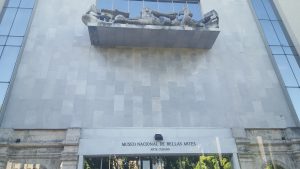
Museum of Fine Art, Havana.
The first place we went was the Museo Nacional de Bellas Artes. This is the national museum of art located across from the Museum of the Revolution. This museum featured Cuban art from every period of Cuban history. The art was much more beautiful than I anticipated. I found that while it had a certain European style, it also had a distinct Cuban approach. Some of my favorite works that I saw included: Servando Cabrera Moreno’s Milicias campesinas, Marcelo Pogolotti’s El intellectual o Joven intellectual, and Victor Manuel García’s Gitana tropical and Río San Juan. Many of these paintings created by Cuban artists was nothing like I have ever seen before. There were also many sculptures throughout the museum. I also really liked that one of the exhibits featured art created by Cuban kids. This exhibit was really cool because it focused on Cuban kids’ art while at the same time providing a history lesson to Cubans and tourists alike.
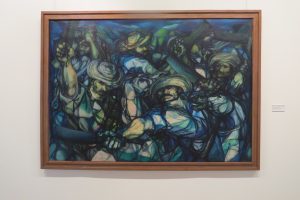
Servando Cabrera Moreno’s Milicias campesinas, 1961.
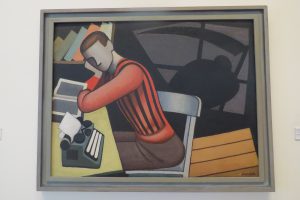
Marcelo Pogolotti’s El intellectual o Joven intellectual, 1937.
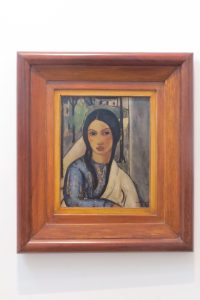
Victor Manuel García’s Gitana tropical, 1929. Also known as the “Cuban Mona Lisa”.
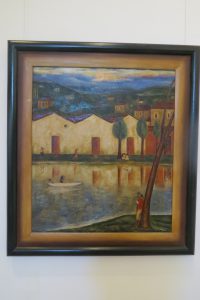
Victor Manuel García’s Río San Juan, 1943.
Another interesting exhibit at the museum was the “El Hueco, un espacio del Arte contra la Injusticia” (A space for art against injustice). This space was created for every person to reflect on the punishment of solitary confinement of seventeen months imposed on the Cuban Five by the United States. This exhibit featured watercolor pieces done by the members of the Cuban Five. This installation was meant to give Cubans a firsthand account of the terrible experience endured by the Cuban Five. While we did not get to go in, as it was closed, this exhibit was sobering to experience nevertheless. It was impossible to imagine what life was like for the Cuban Five in solitary confinement, but instead of responding with violence, they responded with art and a warning for the future. Similar atrocities should never be repeated and this exhibit serves as a reminder to the public to never forget.
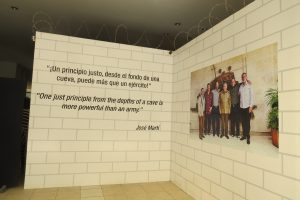
“El Hueco, un espacio del Arte contra la Injusticia”
After the art museum, we traveled about thirty minutes outside of Havana to a beautiful beach. The water was warm and a beautiful shade of turquoise blue. It was one of the most beautiful beaches that I have been to in my life. The beach offered me a chance to relax after a long week of going nonstop. After swimming for an hour or so, a few of us decided to take a walk down the beach. Along our walk, each of us collected pieces of sea glass and pretty shells that we found in the beach sands and among the seaweed. There is nothing better than enjoying a warm day on a tropical beach when everyone back home was experiencing winter weather.
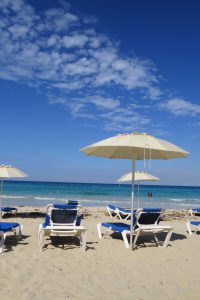
Blue skies and turquoise waters.
After the beach, we went back to the Gran Teatro de la Habana Alicia Alonso. We had visited this the day before to see Swan Lake performed by the Cuban National Ballet. We were lucky enough to purchase seats in a box on the left side of the theater the day before. The costumes were spectacular, and equally magnificent was the backdrops created for the various settings of the ballet. The dancers were stunning, their footwork was impeccable and the entire performance I watched with awe as they danced through complicated footwork and graceful leaps. Before visiting Cuba, I did not realize there even was a national ballet company and did not realize that I would be lucky enough to witness a performance firsthand. It is an experience that I will never forget.
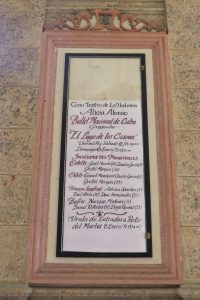
Program posted outside the Opera House.
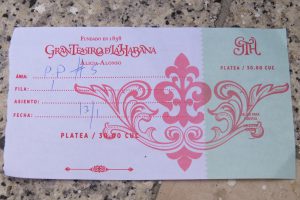
Ticket for Swan Lake Ballet.
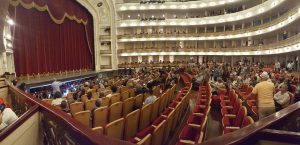
Inside the Opera House, before the first act began.
Even later that night, we went to Club 1830 in Havana. This club is known for outdoor salsa dancing by the water. It was a chance for us to interact with the locals and try out our salsa dancing skills with them. The club was full of energy and blasting Cuban music. The energy of this place was absolutely amazing. Everyone was dancing, laughing, and generally having a good time. Many of us stayed until the early hours of the morning.
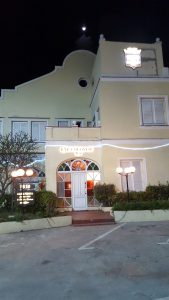
Outside Club 1830.
This day in Cuba was absolutely one of my favorites. We got to do so many exciting things and experience a vibrant Cuba filled with art and music and sun. The fine arts museum was more amazing than I though it would be. It was full of beautiful pieces of art created by painters that I never heard of before coming to Cuba. Swan Lake was one of the most beautiful performances, either ballet, play, or musical that I have ever seen. Everyone was sure to remember their few hours at the beach because most of us left with sunburns, in January. It was one of the most memorable days of the trip.
This was the second Saturday of our stay in Havana. This meant that we had become familiar with places around the city that we enjoyed spending time at, and we started to develop habits around the types of things we would do during our free time.
This day began with a field trip to the opera house in Old Havana. Many of the buildings we had seen and toured by this point were elegant, but somewhat run down and neglected. Walking into the opera house amazed all of us at first sight. The main stairway was stunning and well kept. The grand foyer had photos of the ballet dancers displayed around for viewers to gaze at. It was interesting how much the Cuban government and people valued these forms of art which were evident by the amount of work and money invested into maintaining the building and developing the performances. Because several of us were so impressed by the impression we were given of the performers and space, we decided to buy tickets to see Swan Lake another night.
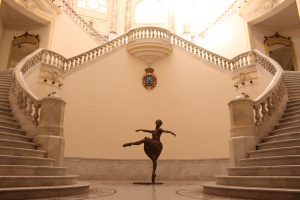
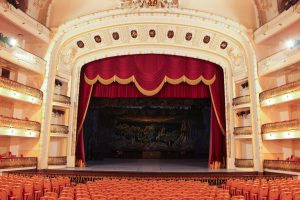


After our tour of the opera house, we were allotted several hours of independent exploration time to explore Old Havana. My roommate Denia and I decided that we wanted to go back to a lunch spot that we were introduced to on one of the first group lunches in the city. The restaurant was a paladar, a privately owned and operated restaurant. One of increasingly many permitted by the Cuban government. It was a small place that looked old and rustic on the outside, but modern and trendy on the inside. It was located on the second floor and had a balcony where Denia and I sat. She ordered shrimp, and I ordered Ropa Vieja. Our meals came with rice, beans, and a salad. We really enjoyed the food and the atmosphere of the place. We could see all on the busy side street below us, and we even engaged in a conversation with some waiters at the street corner trying to catch wandering tourists to point them in the direction of their restaurant. 
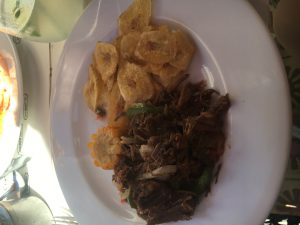
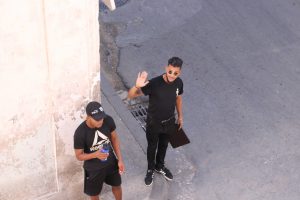

After our meal, we spent the rest of our free time roaming new streets in Old Havana, trying to see if there were more shops full of artwork that he hadn’t seen before. We had just spent time in a familiar place and we wanted to see more of what the city had to offer, so we hit the streets with open eyes. Along the way, we saw some people working on putting stones in the streets and even a man sharpening a knife using a bike.
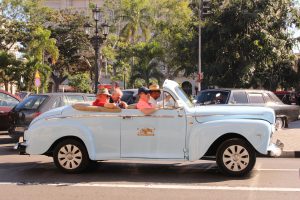
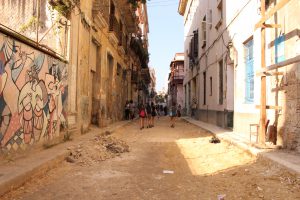


When it was time to meet up with the group again, we started walking towards the waterfront to meet at the Rom Museum. The tour at the museum was quite interesting. Among the many things we learned, we learned that sugar cane came from Asia, not the Caribbean, but because the climate conditions were so good, the sugar cane industry exploded in Cuba. We also learned about the old and new techniques for making rum. This was also a very modern place, that looked rustic on the inside, but very well kept on the inside.
This day also happened to be Denia’s birthday, so at dinner back at the Residencia, she was surprised with a cake that our API coordinator bought for her. This was a great moment and we all really felt like a family coming together over the past week.
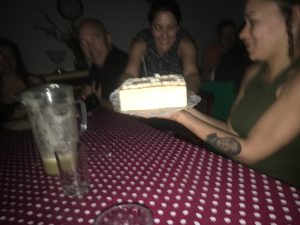
Later that night, our professor wanted to take us through a long walk in Central Havana to a famous rooftop restaurant that he had fallen in love with because of the views of the city. It had been featured in the film Strawberry & Chocolate, the only Cuban movie to ever be nominated for Best Foreign Film at the Academy Awards. It was not only a new and enjoyable experience to be in the atmosphere of the rooftop, but it was also a fun journey to walk there in the heat of the night. We saw a lot of local people playing music and dancing and singing half in their doorsteps and half in the street. We saw many men sitting around a folding table under a streetlamp playing dominos. It was cool to witness what life on a normal neighborhood street feels life vs. one that is catered towards and inviting to tourists, like those in Old Havana.

After we spent some time at the rooftop, our professor took us to another place not too far down the street where Andrew went up on a stage and told some jokes while the rest of us chatted and played card games to enjoy the night the time we had together.

This day was full of breaking from the patterns and exploring the unfamiliar. Each time we found something new, we were pleasantly surprised and impressed by what we found. The places that we discovered that day ended up being places that we wanted to return to later. On other days we went back to the waterfront to take the ferry across the water, and we went back to the rooftop to see the view in the daylight and sunset, for the spectacular colors on the buildings.
Today, January 11th marks one full week in Cuba. As mentioned in the other blogs, so much has already happened, and we have seen so many different things. But today our lesson was focused on Cuban music. The professor, Ruben, made the class fun and interactive with all the different instruments we were able to use and play. Ruben taught us the history of the different music styles in Cuba, specifically the Punto, Rumba, Conga, Contradanza, Danzón, Mambo, Cha-cha-cha, and Son. In each particular genre/style we started with a brief explanation of its history and then immediately started using instruments to create our own music. We began with the clave (two sticks that are hit together), then added the güido (hollow gourd that you run a stick on the outside), then the maracas, and finally, Ruben would join on his guitar and sing along. Each time was incredible and so fun to hear. Sure, we were not always 100% successful, as some of the beats were weird and different than what we were used to in the United States. Following playing, we also learned the dances that went along with the particular music types. When it came to dancing, the musicality came naturally to some while others had a harder time. But, regardless, everyone enjoyed the dancing and had a fun time.


At lunch, we had a delicious Cuban feast (chicken, pork, beans, rice, and a salad, no tostones though so that was kind of sad). But at the restaurant, there was a group that played live music. This was a fun integration of what we had just learned with where we now found ourselves. The musical group was amazing, and a few students even got up and practiced the dance moves we had just learned. Our amazing bus driver, Arturo, helped those students dance along with the music.
Following the delicious food, we ventured to another municipality and toured a Health Clinic. The particular clinic we visited was a polyclinic, which meant it encompassed many different specialties (ie. dentistry, psychology, rehabilitation/physical therapy, and emergency services). Being an exercise physiology student, I was very excited to see the facility. Walking through the clinic was a surreal experience. In a way, it felt like I was transported back to the 1950s or 1960s and walking through a hospital in the United States. Obviously, the clinic had all the required machinery (beds, x-ray machines, lab stuff, etc.), but it all seemed dated compared to what I was used to. It really amazed me how to both the patients and the doctors, they were not hindered by the equipment they had.


Following the walkthrough, we all had a short question and answer session with the main doctor and nurse in charge at the clinic. Here we learned even more about not only the Cuban healthcare system but the clinic specifically. Firstly, and probably the most jarring for Americans, is that Cubans have free universal healthcare. Additionally, there are three different levels of doctors in Cuba. Primary being the doctor’s offices or clinics, secondary are the hospitals, and tertiary are specialized institutes. The clinic we went to was at the primary level and deals mostly with prevention and promotion. Also, one student asked about the gender differences in doctors. At the particular clinic we visited, there were more female doctors than male doctors, which is very interesting considering it is not like that here in the United States. Also, like every other developed country, children receive vaccinations. But unlike the United States with the small group of people who are anti-vaccine, people in Cuba vaccinate, as it is vital to living and saves lives. It was actually kind of funny since the nurse answering the question could hardly believe that such people existed.
On top of that, the two healthcare systems found in Cuba and the United States are polar opposites. In Cuba, it is slow, low-tech, free, but extremely good at ensuring no one slips through the cracks. But in the United States, healthcare is very high-tech but expensive which means a lot of the basics are not dealt with like they should be. But what is most surprising is that the United States has a higher infant mortality rates than Cuba. In the United States, it is 5.9 per 1000 live births, but in Cuba, it is 4. Somehow, despite their older and slower medical practices, Cuba is able to beat the richest country on earth.
But regardless of those specifics, it seems like the clinic was another example of Cuba’s time warp. In a way, Cuba has feet in both the past and the present. Its equipment was extremely dated, but its methods and procedures are modern. Just like with the music we learned in the morning, it has evolved from older styles, which are still known today, but continues to change and evolve over time, like so much else in the world.
When one asks a Cuban citizen about the accomplishments of the Revolution, one would get responses that include universal healthcare, independence, and most importantly their public education system. Education and the origins of the education system in Cuba would be the overriding theme of the day. After a delicious breakfast of fresh scrambled eggs, sweet pancakes, refreshing guava, and Cuban coffee we headed to Centro de Estudios Martianos (CEM). This is where we attend lectures on the culture, economy, and history of Cuba during our two week stay. On this particular day, we attended a lecture that focused on the education of Cuba pre and post-Revolution. Before this lecture I had a basic knowledge and understanding of the Cuban education system. I knew that there were some similarities to our system of education, like having public schools and similar grade structure such as kindergarten, elementary, middle and high school. I did not expect, however, to be so intrigued with this particular topic. I was amazed at how the government was able to transform their education system from an inconsistent and disjointed entity into a public and all-inclusive institution that allowed the country’s future generations to thrive.
To start off our lesson, we learned there was a huge gap between the public and private institutions before the Revolution. Those who were more affluent and could afford the private institutions, known as the Bourgeois class, were also able afford private tutors to teach their children. This meant they received a far more advanced education than those who attended the public institutions. Since many from the lower class were not pushed to attend school the country’s youth suffered. Illiteracy was also a prevalent issue. This was simply unacceptable to Fidel Castro who made it a priority to fix this education problem that had been ignored by the government under President Fulgencio Bautista. Castro wanted to solve the problem of illiteracy in Cuba and educate the new generation based on the ideals of socialism and their culture. It was of dire importance to the masses he proclaimed. The call was made to the people of Cuba. School towns were made, teachers began to have more jobs, and all the children of Cuba were able to attend school no matter their financial situation. There was now the ability to create schools for those with learning disabilities and the visually and hearing impaired. I was truly fascinated by the progress that was made after the change in power.
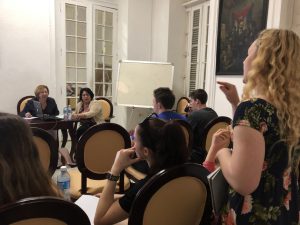
I enjoyed every second of this lecture and I can attribute the strong interest to this subject mostly to the knowledge or our Cuban professor. Before starting the lecture, she had us make a list of questions we had about the topic of education. I thought this was extremely helpful and, in a way, refreshing. I had never had a professor start a class like this. I also was extremely jealous of the students at the University of Havana because unlike in the United States college is free. Yes, you heard me, FREE! No need to pay to get your degree even if you want to pursue a career in healthcare, like me, which means a lot of payments over many years. After an hour and a half, which seemed to fly by, we headed off to our next destination but not before we stopped for a quick lunch. At this restaurant we were able to have juicy barbequed ribs, white rice, beans, and a little scoop of chocolate ice cream for a snack.
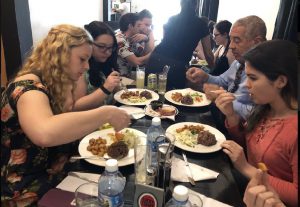
After lunch, we traveled to the Museo Nacional De La Campana de Alfabetizacion (Literacy Museum). We learned about the Cuban Literacy Campaign in which Castro called upon the people of Cuba to help educate their fellow Cubans across the nation. They were to end illiteracy by the next year. According to the museum curator, in 1961 before the campaign commenced the illiteracy rate in Cuba was 23.6%. A year later it dropped down to 3% in 1962. How was this feat achieved one may ask? Well it was carried out by young Cuban students and workers. These students answered the call by going out into rural areas and teaching the people how to read and write. For many kids this was their first time away from home. About 100,000 students nine and up, according to the museum curator, went out and taught. It was far different from their lives in the cities and they also had to deal with the danger of experiencing counterrevolutionary backlash.When I was nine, all I had to think about was what snack I was going to eat after school while I watched Full House. Eight of these students/workers were killed by counterrevolutionaries for teaching the people of Cuba how to read and write. To think these students had the possibility of getting killed while helping their fellow Cubans is eye-opening to say the least. It makes you think about your own life and remind yourself how lucky you are to have all that you do.
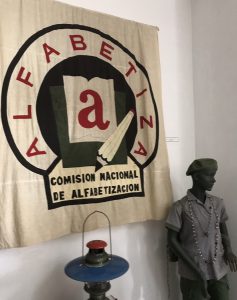
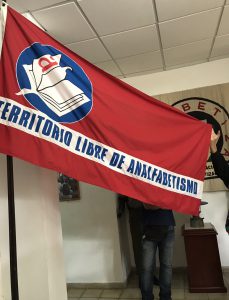
The museum also had on display a chalkboard where gashes were visible from gunshots it sustained during the Bay of Pigs invasion. It was a profound sight to see how large the gashes were and how the original drawings from before the battle were kept on it. Some communities were caught in the crossfire. Pictures of the select students and citizens who were killed by the counterrevolutionaries were on the walls. The students were not much younger than my brother, so to see their young faces on the walls and hear about the horror they endured was heartbreaking. There was also pictures of various citizens, including a 102-year-old woman, who had learned how to read and write. Making it to 102 is a huge accomplishment, but being able to have the mind at that age to learn how to read and write is out of this world. It was inspiring to see how a whole country was able to come together in order to achieve such an amazing feat. They wanted to provide their fellow citizens an opportunity to be able to interact in a new way with the people in the Cuban society. One exhibit that stood out featured select letters that the citizens wrote to Fidel Castro as proof of their success. This may not be the most efficient way to prove this huge feat, but nevertheless it got the point across that Cuba was able to increase the literacy rate by 20% of the population in just one year. Cuba has influenced many other countries and has helped them establish these types of literacy programs in their own countries. One of the most recent efforts can be seen is Bolivia.
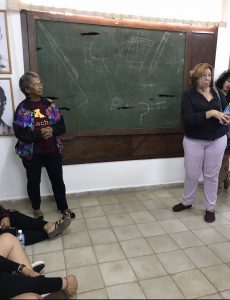
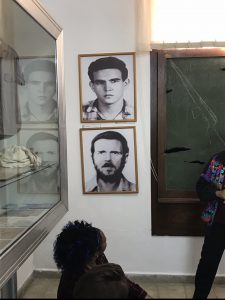
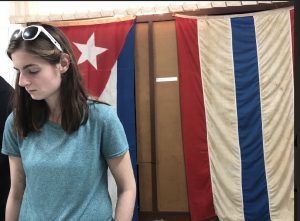
Today our adventures began by visiting Quisicuaba, which is a sociocultural diversity project as well as a place for meal preparation for the community. Quisicuaba was started by a family whose goal was to feed the surrounding community. The building itself was bright and fun and mimicked the people who we met inside. The generous family who started this place did so for the betterment of the community, and has been doing so for many years. In one day they feed over 500 people. Most of these people are part of the LGBT community, are HIV positive, or are alcoholics. What stood out most to me was how deeply these people cared for their community. For them, this did not seem like a job, but rather an activity that they wholeheartedly enjoyed doing. I was amazed that even with the lack of resources that is common throughout Cuba, they were still able to do so much for so many people. It showed such a sense of community and coming together that can be seen throughout all of Cuban culture. Originally we were supposed to help prepare and distribute meals, but unfortunately, as Cuban life goes, things do not always work out like you plan. Even though we were not able to help, we all still felt such a sense of community just by being there and learning about what they do.
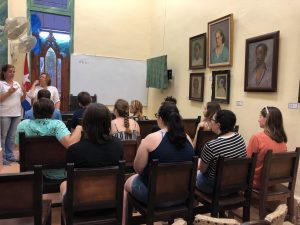
In addition to being being a place for meal preparation, Quisicuaba is also a museum. Specifically, it is a social museum, and the only of its kind it in the world. As a social museum, it brings together many different religions and various artifacts that have been common in Cuban culture through many generations. In addition to showcasing these pieces of history, this museum was also set up in the layout of a typical Cuban house. This museum truly made us feel like a part of the culture, both past and present. Learning about the religions that make up this diverse culture in what mimicked a true Cuban home gave us even more of a sense of coming together with the Cuban culture.
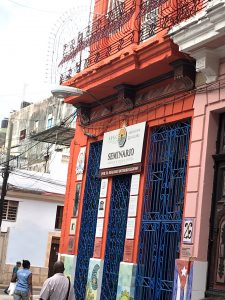
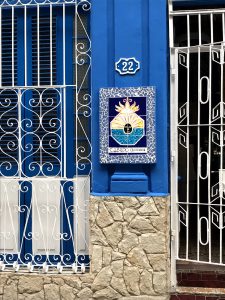
With the extra time that we had as a result of being unable to do some community service, we decided to walk to where we were having lunch instead of taking the bus. Up until this point we had been in mostly nicer parts of Havana, so this walk through a not so nice part of Havana was like seeing the other side of paradise. It was interesting to mesh the two different communities that we have seen together: Old Havana, with its touristy shops and relatively well-maintained buildings, and then just steps away a part of the city that may not have looked as nice, but still held so much culture within it. Havana is much like any other city in the world, which has been my main takeaway so far this trip; despite what we might think as a result of some of the negative things that we hear, this country really is not that much different from ours.
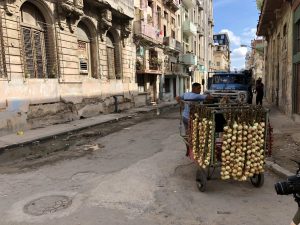
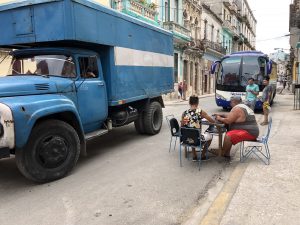
After lunch we had a lecture about the history of student movements in Cuba given by Jorge Lozano. He was extremely passionate from the very beginning. He detailed the many different student movements throughout Cuba’s history, as well as some history about schools in Cuba. One example of these movements that really stood out to me was the first national student conference held in 1923. At this conference, the students of Cuba came together to implement the ideas of Jose Marti into their schooling. A major idea of the Cuban schooling system was ascension, meaning always going up and improving, and this conference demonstrated one of the best examples of this idea. This lecture showed us how the history of Cuba is really about coming together for a certain cause, which was really the theme demonstrated throughout today.
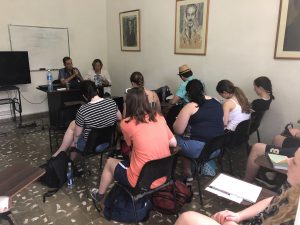
After our lecture we had a different kind of class: a Cuban dance class. Instead of sitting in a classroom and being lectured on a topic, this class had us up and moving. We were all relatively unsure of how this was going to go at the beginning of the class. Despite practicing together the night before, most of us did not consider ourselves dancers and were nervous about how it was going to go. As the class went on, we all really started to get it, and as a result of that really began to enjoy ourselves. What started as awkward movements and being generally unsure of what we were doing turned into an enjoyable experience that none of us will soon forget. Much like how the community came together with Quisicuaba, and the students came together for various movements throughout Cuban history, we all came together and learned how to salsa. While we did something radically different than the previous adventures of our day, that sense of coming together and being involved in the culture was still present throughout the class. Cuban culture can be characterized in many ways, and one of these ways is by the people coming together for all different kinds of causes. Today we embodied that idea in all of our adventures, making us truly feel like a part of the Cuban culture.
Before coming to Cuba my thoughts about sex and the LGBT community in the country were based off what I read about other countries in the Caribbean. Not much discussion on safe sex practices, and prevalent homophobia and transphobia were my expectations. That was until our group visited CENSEX, the Cuban National Center for Sex Education. CENSEX is an organization advocating to teach safe sex practices and provide reproductive services to all Cubans whether they be gay, straight, bi, cisgender, or transgender. For instance they provide free condoms, and other reproductive services for the Cuban people. Listening to the spokesperson for CENSEX I found all of my preconceptions and blanket statements I had made about Cuba blown out of the water. In Cuba the government will provide free surgery for those seeking gender reaffirming surgery, and CENSEX works with trans individuals to help them find jobs where the work environment is not hostile to their gender identity. Additionally the spokesperson told us how marriage equality might be coming to Cuba soon with a referendum set for February.
Although she did concede that Cuba was not perfect and homophobia and transphobia were still problems, the fact that there was a whole organization set up to help LGBT Cubans was above and beyond what I expected. Later when we were allowed to explore the building for a bit I noticed portraits of trans women on display. In the United States that kind of positive visibility of trans women is not something I’m used to. It was a beautiful moment for me to see people that could be shunned in society being put on display through these beautiful portraits.
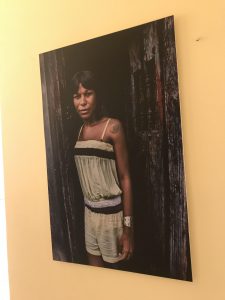
After lunch our guide Ana Elena took us to El Museo de Revolución, or the Museum of the Revolution. Going into this museum I knew I might learn something new or different about the Cuban Revolution, but I didn’t realize how differently Americans and Cubans view our shared history, or how that would hit me emotionally.
Set in the old president’s palace, Cuba’s history of revolution was evident throughout the building. There were even bullet holes still left in the marble from a previous attack of students against the then president Fulgencio Batista. Walking through the museum I was struck by the grandeur of the former palace with its beautiful artwork, and marble pillars. Continuing through the museum I began to read the exhibits, and the information they presented about the revolution. For instance, after the revolution there was a subsequent mass migration of Cubans off the island, with the United States leading many of the programs. In the United States I had been taught children were fleeing the island through the Peter Pan Program due to their home becoming unsafe. However, in this museum the Peter Pan Program was described as a way the United States separated Cuban children from their families. Reading that was jarring to me on an emotional level. Realizing how different two countries could view the same event in history was never something I considered had real world implications.
This jarred feeling carried with me to outside the museum, where our guide showed us the 1962 display of a crashed U-2 spy plane that American Rudolf Anderson had piloted, and been shot down and killed in. The Cuban government refused to hand over Anderson’s body until the American government admitted to sending a spy plane to Cuba. For years neither government would budge, and Anderson’s body was kept in a morgue in Cuba. It was after this story that our guide Ana Elena said, “Your country has its problems, and my country has its problems too. I’m sure you can understand that despite its problems, I still love this country with all my heart as I’m sure all of you do too”. It struck me in that moment that even though our perception of history was disparate, and our countries might seem incredibly different at first glance, that we still shared the same pride for our respective countries.
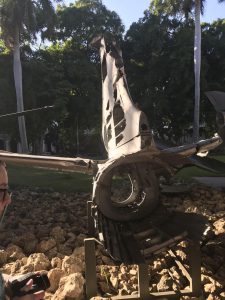
Coming back from Cuba, this lesson has stuck with me. Often, we are taught the world is so much different from our own life in the United States, and in many ways it is. However, that pride for the place you call home, at least in Cuba, doesn’t seem all that different.
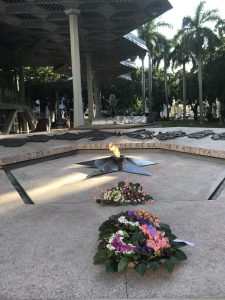
The worn streets and plazas are overflowing with activity. As soon as one song fades from our range of hearing, a completely different one takes its place. Stray dogs and cats trot about with confidence. Strong odors, alternating between pleasant and offensive, attack our nostrils. People to the sides either try furiously to attract our attention or gaze at us with mild curiosity. We weave our way through the throngs of people, doing our best to take everything in.
Today is our third full day in Cuba. Over the past few days, we’ve explored Ernest Hemingway’s dwellings, been solidly defeated by a local youth baseball team, and gotten a feel for our residential neighborhood of Vedado. Now, we are making our way through the fascinating historic district of Old Havana. I have noticed so many new details that I forget that it is our second journey through this bustling labyrinth of streets, plazas, and alleys.
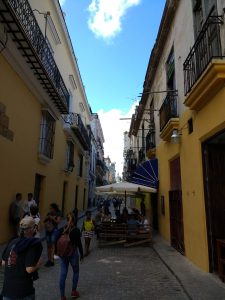
We had started our day at the Centro Estudios Martianos. Like many things in Cuba, this location is tied to the name of José Martí. No one title – academic, poet, revolutionary, writer – is adequate to describe this legendary figure. Though he became a martyr for the cause in his first battle, Martí was the face of the Cuban War for Independence (AKA the Spanish-American War) and a hero among Cubans. We have already encountered his image more times than I can recall. In a small yet comfortable classroom (which featured no less than four of these images), our guest lecturer provided a brief overview of Martí’s life and work. The speaker emphasized his humanist perspective and universal value of his writings. As she admitted herself, however, explaining the importance of a man so central to the Cuban identity is an impossible goal for a single lecture.
Following the lecture and a coffee break, we dined at a paladar, a private restaurant sustained primarily by the business of tourists. These venues tend to provide far superior food and service compared to the state-run restaurants. Today’s lunch was among the best meals we’ve had so far, featuring typical Cuban cuisine: rice, beans, fried plantains, chicken, and ropa vieja, a signature dish consisting of shredded beef. Later, our plans to visit Martí’s memorial were thwarted by an issue with the site’s electricity. Such unforeseen problems in Cuba are not uncommon, and adapting to them is a part of the experience of living here. In keeping with this spirit, we had been released to explore the city independently for the remainder of the day.
Here in Old Havana, I find that my eyes are continually drawn upwards, enticed by architecture that remains beautiful despite its age. No two buildings are the same. Intricate columns and etchings are prominent not only on churches, but also on businesses and residences. Many buildings are covered in solid coats of paint, some of which have been bleached by the intense sun. Staircases, facades, and balconies jut into the straight streets. We frequently spot the Cuban flag suspended proudly above. With every sighting, I am gradually realizing that Cuban patriotism rivals that of the United States.
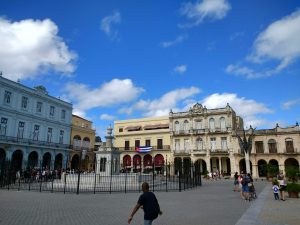
Our return to the logical grid of Vedado is just as stimulating. Every zone we’ve entered has been packed with points of interest. As we near the edge of Old Havana, we find ourselves in the vicinity of the capitol building, the Great Theatre of Havana, Hemingway’s favorite bars, and the former Presidential Palace. Here, the wider streets are shared by large tour buses, horse-drawn carriages, ancient cars, and anything that fits Cuba’s loose definition of “taxi”. Later, the route takes us along the Malecón, the sea barrier that extends for miles along the coast and is informally known as “the city’s couch”. Despite the nearby skyscrapers and busy roads, Cuba’s natural appeal is as strong as ever here. Pelicans soar through a brilliant blue sky. Waves hurl themselves against the base of the Malecón with such ferocity that spray leaps over the wall. Lush tropical plants frame the sidewalks and buildings. It is easy to see why the island was a top tourist destination in the years leading up to the sweeping Cuban Revolution.
As we approach the recently-reopened U.S. embassy, Martí makes yet another appearance. A dramatic statue of his unmistakable figure stands several hundred yards away from the imposing building. With one arm, he shields a young child; with the other, he raises an accusing finger towards the embassy. The scene is a reminder of the complicated, often-antagonistic relationship between the island nation and its northern neighbor. With the Cuban War for Independence, the island prevailed over Spanish imperialism only to face a new challenger in the United States. Hostility between the two countries reached a maximum sometime after Fidel Castro’s Communist revolution, and the U.S. embassy remained closed for most of the Cold War and beyond. Its reopening less than four years ago was one of many landmark strides made by President Obama and Raúl Castro. Today, however, lingering political differences, thorny issues, and President Trump’s apparent indifference towards Cuba have given the nations’ relationship an uncertain future.
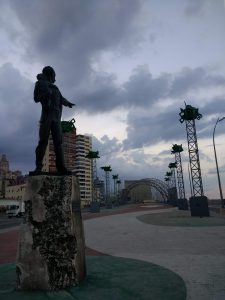
Perhaps this unusual history with our own nation explains my unusual feeling; exploring Cuba feels like exploring something forbidden. It is a country that has only recently opened up to the U.S., one that is just starting to pick up technologies that are commonplace for us. Strange as it is, this feeling is overwhelmed by my excitement. The city’s undercurrent of energy is palpable both night and day. It beckons us to explore, and we heed its call almost feverishly. Though it is impossible to experience everything it has to offer, I am certain that Cuba will continue to amaze me in the coming days.